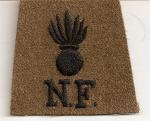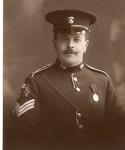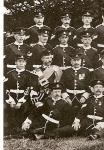-
Posts
1,065 -
Joined
-
Last visited
-
Days Won
1
Content Type
Profiles
Forums
Blogs
Gallery
Events
Store
Everything posted by Graham Stewart
-
Once in awhile something will come along and just leave you puzzled and this is a typical example. Got this off an auction site and was the only bidder. Other bidders probably stayed away thinking it repro, but is it? In all my time collecting to the Northumberlands I've only seen this badge appear three times - the first time was on the genuine helmet cover of a steel helmet. The second time at a militaria fair over ten years ago. My honest belief is if it was repro there would be boatloads around, but as said previously it's only the 3rd example I've come across. Any ideas lads as it doesn't appear in Denis Woods book on NF badges?
-

British Star 1914
Graham Stewart replied to Noor's topic in Great Britain: Orders, Gallantry, Campaign Medals
Just a quicky here. If he began his recruit training in 1913 with the 3rd Bn, Royal Berkshire Regt, then he wasn't a regular soldier, he would have been a "Special Reservist". Regular soldiers enlisting at this period of time undertook recruit training at the Regimental Depot, as training for the "Reserve & Extra Reserve Battalions" of line regiments, which in the main where either the 3rd or 4th Bn's, was an annual event. -
As is probably clear from this photo a gap has appeared in the shoulder strap. At the end of the shoulder strap is his shoulder title, which in this case is a three tier Territorial title for the Leicestershire Regt which will be "T/numberal/LEICESTER" (or Leicestershire). No rank badges of any description were ever worn by either senior or junior ranks on their shoulder straps. As for the third medal it's unique shape defines it from all other's as being Volunteer/Territorial forces and you will note Colour Sgt Boyd is also wearing the same shaped medal as he too was a Volunteer/Territorial. If I'm correct your relative will also appear in Army Orders as being awarded this medal, although I'm unsure if they appeared in the London Gazette. A popular misconception is that if you have Boer War Medals you served with a regular unit during the South African War - not true. All regular units in South Africa had attached to them "Volunteer Service Company's" made up of men volunteers from the regiments Volunteer Battalions, who served in S.A. for a period of one year. JAGWCA, Your reference to your own relative wearing the four chevron's with crossed rifles above is 'unique' to regulars on secondment to Volunteer/Territorial battalions, who were termed 'Colour Sergeant Instructors'. Without the fourth chevron you were just a plain Sergeant. I'll try and post a photo of just such. CSI's were generally men who after seconded service returned to their regular unit with a view to becoming Colour Sergeants and wearing their unique badge when in parade order. In service dress there was no such badge designed to define their rank and so they wore three chevrons with a very large crown above.
-
Leigh Did the Volunteer Medal change it's shape to oval at some stage or is the oval medal strictly Territorial, I can't remember and have none of my books here? Having looked at the photo again, I don't think he's a regular seconded, I've a feeling this lad is definately either a Volunteer or even Territorial, depending when the photo was taken. Is it definately a crown above the crossed rifles, as it looks really small and I was wondering if it was the 'Proficiency' star, which would be correct for a Volunteer or Territorial?
-
The third medal which appears next to his South African medals, appears to be the Volunteer Long Service Medal, due to it's oval shape. One of the criteria for it's award was twelve years service in the Volunteer movement, so this isn't a regular Leicestshire Battalion he's serving with. This is the later 'Territorial' medal, which replaced the Volunteer one, but kept the same shape.
-
To enhance my point about him not being a Colour Sgt, this is Colour Sgt Boyd, 6th Bn, Northumberland Fusiliers wearing the Colour Sgt's badge. If you look at your grandfathers photo a gap has appeared on his shoulder strap, allowing the tent background to show through, giving the inpression of another badge, which I'm afraid isn't there.
-
Just a couple of points about photo 1. Although dressed in scarlet the cap badge worn doesn't appear to be a regular pattern Leicestershire Regiment badge i.e. there's no "Hindostan" scroll above the tiger. This suggests to me that when this photo was taken he may have been seconded or actually serving with either a Volunteer Battalion or Territorial Battalion of the Leicestershire Regt. Secondly his rank in this photo, if my memory here is correct, he is a 'Sergeant Instructor of Musketry' and not a Colour Sgt, who wore the large crossed Union flags where the crossed rifles are positioned. No crossed flags would be worn on the shoulder strap.
-

MILITARY MEDAL - WW1
Graham Stewart replied to a topic in Great Britain: Orders, Gallantry, Campaign Medals
Not sure if you're aware but the unit title is actually the 2/2nd(Home Counties)Field Ambulance, RA.M.C.(TF). His six figure number on the medal was actually introduced for all members of the Territorial Force in 1917. For the moment I can't tell you which Division served with, although I suspect one of the Home Counties Divisions, as all of my ORBATS are at home in the UK, so I'll have to look elsewhere. -

Last TA VC?
Graham Stewart replied to bigjarofwasps's topic in Great Britain: Orders, Gallantry, Campaign Medals
For the moment I can't tell you who was the last TA,VC, but speculation that World War One last saw a TA,VC is incorrect as Lt Richard Annard 1/8th Bn, Durham Light Infantry was the first TA,VC winner of the Second World War when he saved his badly wounded batman with the aid of a wheel barrow in France in 1940. Unlike the Great War, the TA played a more prominent role as fewer war raised Service Battalions were formed and so there should be a few TA,VC's. I've checked various online source, but there appears to be no definitive list of VC Winners at all. -
Hi lads, Still in the land of sand and camels I'm afraid. Anyway thanks to TI for reproducing the 3rd V.B.,N.F. pipers plaid broach. Sadly I haven't come across a list of pipers in 3VB and so can't give you any further information on J.Stewart, who may have left prior to the formation of the TF in 1908, as he doesn't appear in any WWI lists. Apparently there were no more than half a dozen at any one time. Attached hopefully is a photo showing the Pipe Major among 3VB's Sgt's taken Ripon, 1907.
-
Hi Gordon, Yes it's currently the subject of discussion on the GWF. This 'discovery' isn't what it seems, as it seems some of us were quizzing the IRC about these records years ago. I was asking questions about POW's lists in 1989 and the answer then was only "information can be given to blood relatives". Fortunately those I've helped find their relatives who were POW's got some good results from the IRC records, but it's annoying to hear that 'no-one has ever asked about them', which isn't strictly true, we've actually been "denied access".
-

What unit?
Graham Stewart replied to Stuart Bates's topic in Great Britain: Militaria: Badges, Uniforms & Equipment
The bit was worn by both the RFA & RHA as it originally indicated 'collar maker' but later known as 'saddler', 'saddletree maker' & 'harness maker. The badge covered all horse units including cavalry, R.Engineers, and ASC.. This also inlcuded R.Signals on it's formation. -

British Order of Battle
Graham Stewart replied to Christian L's topic in Great Britain: Research, Documentation & History
Christian, What you require are Major A.F.Beckes "Order of Battle of Division", which cover the whole of the Great War in 5 parts. It was a very rare series, which was reprinted by Ray Westlake in the early 1980's and even those copies are considered rare due to their quality. Part i - The Regular Divisions. Part II - The Territorial Divisions Part III - The New Armies Part IV - The Reserve TF Divisions Part V - Armies & Corps. This was followed by another series for 1914-19 which covered the Australian, Canadian and Indian Divisions and was published by an author who name escapes me. These can still be obtained from book dealers through the 'abebooks' website, but if you decide to order copies, order them direct from the seller as abebooks charge a premium, which is added to the sale of the books. The Imperial War Museum also reprinted an 'Order of Battle of the British Army' for November 1918, but even though done in the 1980's this reprint is hard to come. -
Neither posts #67 or #68 are Cadets as we know them. Post #67 is from the blurred badge a member of the London Diocesan Cadet Corps, which I believe was a branch of the Church Lads Brigade. Post#68 is infact a member of the Church Lads Brigade. Both of these organisations and the Boys Brigade at the turn of the last century were quasi-military in their approach to the discipline of Cadets. The organisations themselves were not only sponsored, but in some cases affilited to local Territorial Battalions who assisted them during annual camps etc, not only with equipment but sometimes instructors.
-
"Titled The "9th (Yorkshire Hussars) Battalion West Yorkshire Regiment", they wore The Yorkshire Hussars cap-badge and West Yorkshire Regiment collar-badges." Leigh, Are you sure about the badge bit? The reason I query is because when the Northumberland Hussars were absorbed by the 9th Bn, Northumberland Fusilies to become the 9th(Northumberland Hussars)Bn, Northumberland Fusiliers the cap badge remained NF and the collar badges remained Northumberland Hussars and the cavalry bandolier was also worn by the transferred members.
-
I too are under the impression they may actually be later rather than Napoleonic, but I have none of my uniform books with me. The date Bear has given for similar boards on US uniforms seems to ring a bell with similar boards being worn by the British Army during the same time period. At the same time a castle wasn't peculiar to the 27th(Inniskillings) as it can also be found with the Suffolks, Northamptonshire, Dorsetshire Regiments and would have thought it would have been accompanied by a Foot number and perhaps "Enniskillen" as seen on the plate. At the same time, with the other three units with castle as part of their badge again a Foot number and perhaps "Gibraltar"; "Talavera" or "Primus in Indus" to identify the unit in question. Have you contacted any of these Regimental Museums relating to your items?
-
I personally aren't knocking the LOF, nor do I think are our other contributors to this post, but one cannot help wonder what happend to the LOF to end up with the "Walter's" who have brought disrepute to what was a well respected organisation, which consisted of many brave men who helped create the British Empire. Many years ago at an antiques fair at Brancepeth Castle, I actually saw an early pattern LOF uniform for sale complete with lemon squeazer and often wonder who it had belonged to. It was tempting to buy it at the time but as I was skint I had to leave it.
-

Royal Welsh Fusiliers...
Graham Stewart replied to bigjarofwasps's topic in Great Britain: Research, Documentation & History
Brit humour - priceless. -
One wonders how a much respected organisation at the turn of the century can become so debased overtime. Articles on the L.of.F. did appear in St.Georges Gazette the regimental journal of the Northumberland Fusiliers and in my memory is correct one inlcuded a picture of Roger Pocock the founder of the L.of.F. As far as I'm aware these men were originally adventurers-cum-Empire builders, not Walter Mitty's and would be possibly be regarded as 'pathfinders' in todays military terms.
-

Royal Welsh Fusiliers...
Graham Stewart replied to bigjarofwasps's topic in Great Britain: Research, Documentation & History
There'll always be some controvesy over whether the 'War of Independence' of 1775-1783 was or was not Civil War and our American cousins probably find it difficult to understand that perhaps some 80% of those who actually took part in the affair actually spoke the 'Kings' English without the hint of the American accent we recognise today. Hugh Bicheno's "Rebels & Redcoats" is probably one of the finest books I have ever read regarding the War of Independence and brings home the fact that it was truly a "civil war" fought between brothers, families and friends. I've even read somewhere that Flora McDonald of Bonny Prince Charlie fame, sided with the British rather than follow those who took up arms against the King. Our loss was the world's gain and it said that George III never ever forgot the loss of these colonies and many British who fought there hated having to go to war against their own flesh and blood. Our own nation went onto create the greatest Empire the world has ever known, but one historical question which can never be answered would be what sort of Empire would we have had if the colonies had remained British? -
Know exactly how you feel as it became a bone of contention on another forum I'm a member of. We did eventually discover that the rank of 'CSM' was to be found amongst Mounted Infantry units, who operated on a four company basis and we wondered if this was the model on which the four company reorganisation looked to. The same order also revealed that men promoted to CSM while serving with the MI had to revert to their old rank on returning to their old battalion.









